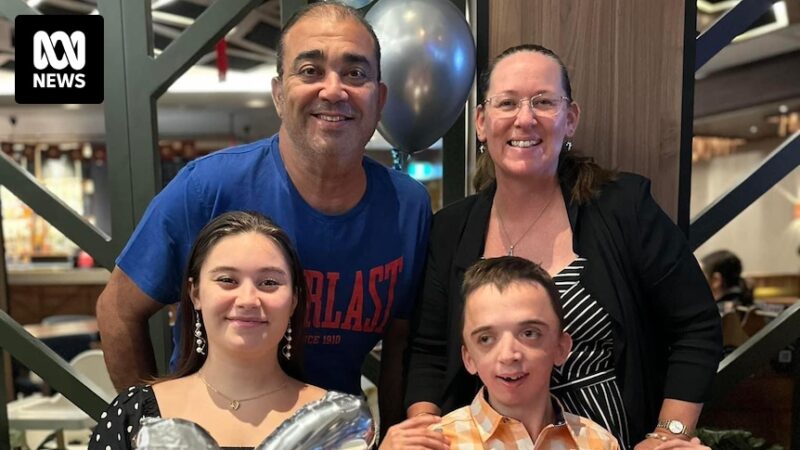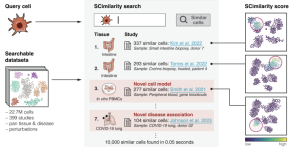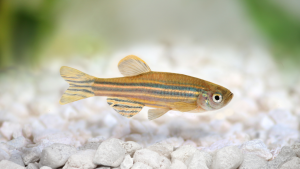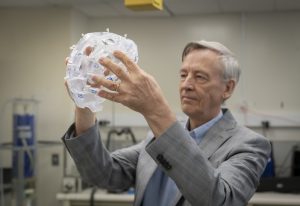Queensland whole genome sequencing study helps diagnose boy with rare Malan syndrome

Dominic Kokolis was born with a genetic condition so rare doctors were unable to provide a diagnosis for most of his life.
Then last month, just before his 16th birthday, his family were finally given a medical answer for what they fondly describe as Dominic syndrome.
His mother Amanda said testing began on Dominic as a baby, but his family had to wait years for technology and science to catch up.
He was finally diagnosed with Malan syndrome — as part of a three-year Queensland Health pilot study using whole genome sequencing of children with rare conditions throughout the state — after multiple earlier tests proved inconclusive.
Dominic — who is non-verbal, uses a wheelchair and has vision problems — is the only known case of Malan syndrome in Queensland and one of 11 in Australia.
The condition was first identified in 2010 and is linked to mutations in the NFIX gene.
Ms Kokolis said the diagnosis had allowed the family to connect with others across the world, and share their experiences.
She said Dominic experienced problems from when he was a baby.
“From the get-go, we had quite a lot of issues,” Mrs Kokolis said.
“They diagnosed him early with global developmental delays. He wasn’t walking … when he should be walking, speech didn’t happen.
“Feeding was an issue. Kids with Malan actually have a high palate and a lot of teeth, a lot of crowding, big jaws. He wasn’t actually creating a seal to breastfeed.”
Ms Kokolis said Dominic would never be able to work, drive, get married or have kids, describing his challenges as “quite a lot to deal with”.
However, she described her son as “a wonderful kid” – cheeky and funny.
“He doesn’t have any behavioural issues,” Mrs Kokolis said.
“He’s happy all the time, which is really great — has his addictions, so he loves cars and wheels, bikes, buses, any kind of transport.
“He sleeps with a truck or a fire truck. He’s always at the window of the house looking for cars going past. I’ve found out, a lot of the kids all have similar obsessions.”
Diagnosis brings relief
Doctors unsuccessfully tested Dominic for different genetic conditions as a baby, including Angelman syndrome.
“Back then, you had to actually test for a specific syndrome,” Ms Kokolis explained.
Whole genome sequencing allows scientists to be able to sequence every gene, giving them a better chance of finding a mutation in a child that results in a medical disorder.
It is expected to become more precise as more conditions are linked to specific mutations in genes.
Genetic Health Queensland director Julie McGaughran said Dominic was one of more than 880 children recruited across the state for the whole genome sequencing project, which has provided diagnoses for 36 per cent of them.
Analysis is ongoing.
“For some of them it’s been years of trying to get a diagnosis and they finally reached one,” Professor McGaughran said.
“Some of them have … very, very rare conditions. It’s a pretty high detection rate.”
Ms Kokolis said finally having a diagnosis gave her family a sense of relief.
“Just knowing that it’s not anything that I’ve done or anything that my husband’s done, there’s nothing we could have done to change this outcome,” she said.
Professor McGaughran said being able to give families an answer to a child’s disorder was “huge” on many levels, but particularly for mothers.
“There’s often that sense of, ‘Was it something I did or didn’t do in pregnancy?'” she said.
Diagnosing a condition in a child also gives their parents and siblings a better understanding of whether they are at risk of passing the disorder to other children.
And, connecting families to others with children who have the same genetic condition can help end their sense of isolation.
‘Increased access to treatments’
Professor McGaughran said the whole genome sequencing project also identified one patient that had a condition “amenable to some treatment”.
“We have found conditions where treatment might be possible and that’s going to increase over time, obviously, as we get better at treating genetic conditions,” she said.
“We expect over time there’s going to be an increased access to a whole range of treatments … once we understand what the cause of a condition is.
“Some of those might be drugs that we can repurpose to treat the children, some might be dietary treatments.”
Metro North Hospital and Health Service, Genetics Health Queensland, Pathology Queensland, and American biotechnology company Illumina joined forces on the three-year pilot project.
For the Kokolis clan, having a diagnosis means they can try and help other families of children who have the disorder.
“Going forward now, I’m all for throwing ourselves into whatever we can do to get the awareness out there about this syndrome because it is so new,” Mrs Kokolis said.
“Maybe it can help somebody down the track of discovering it earlier than we did.”
Despite the challenges of raising Dominic, Ms Kokolis said she “probably wouldn’t change anything if I could”.
“Because we wouldn’t have this journey and we wouldn’t learn as much as what we’ve learnt,” she said.
“Because of my journey with Dominic and the kind of person that I am, a lot people talk to me and say that I’m this wonder woman, I’m this amazing person.
“I’m like, ‘Well, to me it’s just my job as a mum. I don’t think any different to anyone else.’
“My job as a mum and a carer is just to make his life the best life that he can have.”







